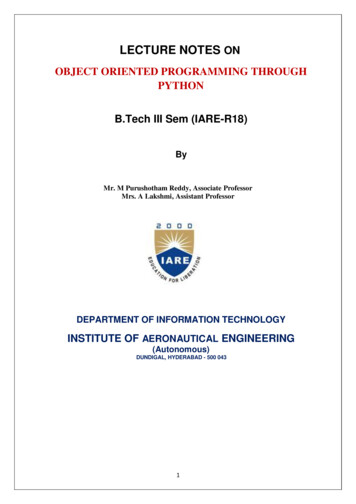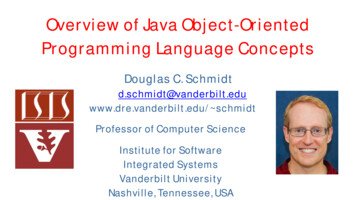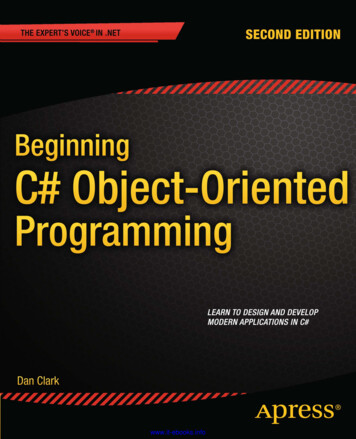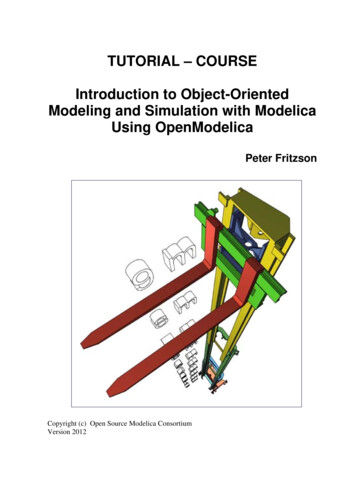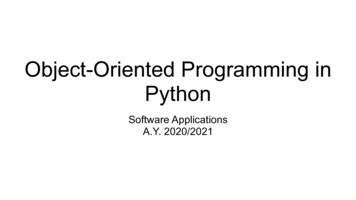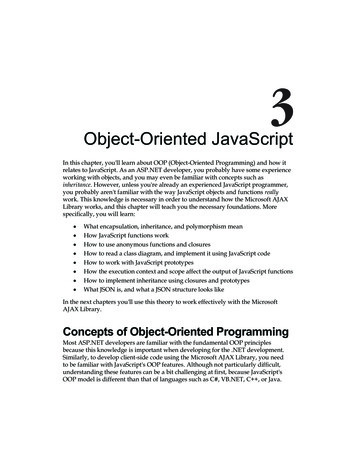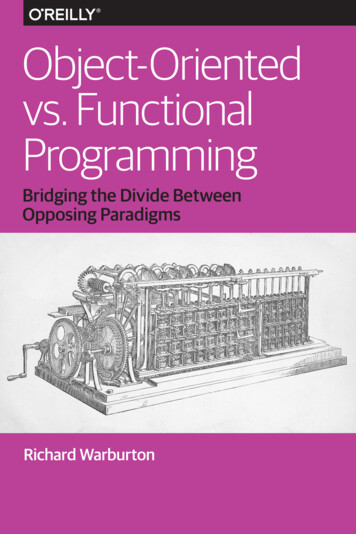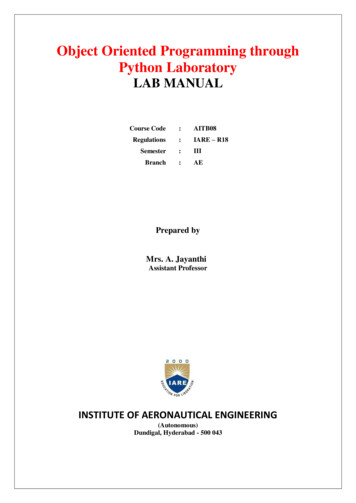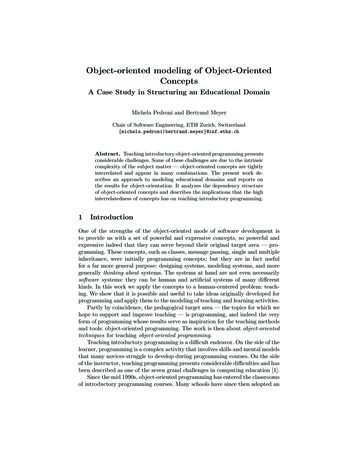
Transcription
Object-oriented modeling of Object-OrientedConceptsA Case Study in Structuring an Educational DomainMichela Pedroni and Bertrand MeyerChair of Software Engineering, ETH Zurich, Switzerland{michela.pedroni bertrand.meyer}@inf.ethz.chAbstract. Teaching introductory object-oriented programming presentsconsiderable challenges. Some of these challenges are due to the intrinsiccomplexity of the subject matter — object-oriented concepts are tightlyinterrelated and appear in many combinations. The present work describes an approach to modeling educational domains and reports onthe results for object-orientation. It analyzes the dependency structureof object-oriented concepts and describes the implications that the highinterrelatedness of concepts has on teaching introductory programming.1IntroductionOne of the strengths of the object-oriented mode of software development isto provide us with a set of powerful and expressive concepts, so powerful andexpressive indeed that they can serve beyond their original target area — programming. These concepts, such as classes, message passing, single and multipleinheritance, were initially programming concepts; but they are in fact usefulfor a far more general purpose: designing systems, modeling systems, and moregenerally thinking about systems. The systems at hand are not even necessarilysoftware systems: they can be human and artificial systems of many differentkinds. In this work we apply the concepts to a human-centered problem: teaching. We show that it is possible and useful to take ideas originally developed forprogramming and apply them to the modeling of teaching and learning activities.Partly by coincidence, the pedagogical target area — the topics for which wehope to support and improve teaching — is programming, and indeed the veryform of programming whose results serve as inspiration for the teaching methodsand tools: object-oriented programming. The work is then about object-orientedtechniques for teaching object-oriented programming.Teaching introductory programming is a difficult endeavor. On the side of thelearner, programming is a complex activity that involves skills and mental modelsthat many novices struggle to develop during programming courses. On the sideof the instructor, teaching programming presents considerable difficulties and hasbeen described as one of the seven grand challenges in computing education [1].Since the mid 1990s, object-oriented programming has entered the classroomsof introductory programming courses. Many schools have since then adopted an
“objects-first” or “objects-early” approach for their CS1 courses, and researchersas well as educators have proposed numerous tools, approaches, and strategies.It has been asserted that for object-oriented programming “the basic conceptsare tightly interrelated and cannot be easily taught and learned in isolation” [2].This complexity is intrinsic to object-orientation and cannot be removed makingit important to develop appropriate tools and processes to handle the resultingchallenges.In programming courses, it seems natural to expose students first to singleprogramming language features (matching the first stage of Linn’s “chain ofcognitive accomplishments from computer programming instruction” [3]). Forobject-oriented programming, it is difficult to isolate single language featuresand to find an initial sequence of single language features (a phenomenon knownas “Big Bang problem”). In addition, the tight interrelatedness of O-O conceptsresults in a higher number of elements to teach, since the instructor must examinenot only the elementary concepts but also their possible combinations. Thismakes it harder to ensure that the teaching sequence meets the prerequisites atall times and that a course covers all facets of a concept.This work describes a modeling approach and the supporting tool for modeling educational domains through their main concepts and the relations betweenthese concepts, and its application to the educational domain of introductoryprogramming.2Truc frameworkA course will never be specified as precisely and rigorously as, for example,a computer program. Still, applying modeling techniques partly imitated fromsoftware and other engineering disciplines can help meet some of the challengesof course design, in particular for object-oriented programming.The Truc framework [4] used in this work models educational domains andidentifies structural dependencies between concepts. It extends the idea of Truc(Testable, Reusable Unit of Cognition) [5] by adding two additional types ofknowledge units. The final model then uses three types of knowledge units (inincreasing level of granularity): notions, trucs, and clusters. In addition, it definesseveral types of relationships between the entities.At the highest level, a cluster is a collection of trucs and other clustersrepresenting a particular knowledge area. A truc belongs to exactly one cluster;the set of clusters forms a hierarchical structure in a directed acyclic graph.At the medium level, a truc is “a collection of concepts, operational skillsand assessment criteria” [5]. Its description follows a standardized scheme withsections on technical properties (for example, its role in the field, benefits ofapplying it, and a summary) and pedagogical properties (such as common confusions and sample exam questions). To help instructors check that their teachingmaterial addresses the misconceptions of students, we have extended the original“common confusions” section [5] with recommendations applicable to teachingmaterial such as slides.
The most elementary unit, notion, “represents a single concept or operationalskill or facet of a concept” [4]. Since the key unit of granularity of the modelis truc, every notion belongs to exactly one truc. A truc may have a centralnotion, which then bears the same name. In our example pedagogical domain,examples of notions within a “feature call” truc are: the central notion “featurecall” (capturing the general idea of a method call instruction), “multi-dot featurecall” (calls of the form o1.o2.o3.f), and “unqualified feature call” (method callswithout an explicit target).To capture the dependency structure of the knowledge units, the Truc framework defines two types of relations between notions. A requires link captures thatunderstanding a notion requires knowing another notion. This relation is comparable to the client relationship between classes in object-oriented systems. Arefines link expresses that a notion is a specialization of another notion; it iscomparable to the inheritance mechanism in object-oriented systems. A refinednotion implicitly inherits all the requires links from its ancestor, but may alsointroduce additional ones. For simplicity, the methodology prohibits refines linksacross truc boundaries.Dependencies at the notion level contribute to dependencies at the truc level:a truc A depends on another truc B if any of its notions requires a notion ofB. Since each truc contains a set of notions, the trucs and notions define atwo-layered graph. The graph provides the domain model for the modeling ofcourses and their associated lectures as a sequence of covered notions. Figure 1shows an extract of the truc-notion graph1 for object-oriented programming.It includes the direct dependencies of truc Feature call and their notions. Thetextual description of an example truc is available in Appendix A.The TrucStudio2 [6] Pedagogical Development Environment supports theTruc approach. It automatically deduces the truc dependencies from the notionrequirements; it provides a graphical representation of the domain model (suchas the one produced for the truc Feature call shown in Figure 1) and a viewof courses as diagrams. Additionally, it offers a customizable output generationmechanism to produce Web pages and ontology files, supports the analysis oftransitive dependencies and cycles on notion and truc level, and reports prerequisite violation within a course.3Model of object-oriented programmingSeveral articles and standards have guided the work of selecting concepts andskills that can serve as a starting point for defining the trucs of OOP. In particular, the article on “the quarks of object-oriented development” [7] identifiesinheritance, object, class, encapsulation, method, message passing, polymorphism,and abstraction as “quarks”. Except for abstraction, all of these quarks appear12To prevent misunderstandings related to the entity type “cluster”, we use the nametruc-notion graph instead of clustered notions graph as found in an earlier article [4].Available at http://trucstudio.origo.ethz.ch
rn tureExport xpressionFeaturedeclarationFeature callMulti dotfeature callArgumentdeclarationSimplefeature callArgument passingTargetFeature callfeature callVoid tem executionRoot classRootcreationprocedureCurrentobjectCall stackReferenceVoidSystementry pointAttachmentRoot objectNotionRequired eAliasingReferenceNotion a requires notion bNotion a refines notion bTruc A depends on Truc BFig. 1: Dependencies of the “Feature call” trucas trucs (encapsulation under the name information hiding and message passingas feature call ).An experiment by Sanders et al. [8] contrasts the expert view of the quarkswith the view of students who recently had studied object-oriented programming.They asked them to draw concept maps [9] that summarize their knowledgeof OOP. The most commonly mentioned concepts are class, method, instance,variable, and object. Other commonly found concepts (implicitly or explicitly) aredata/attribute/instance variable, inheritance, and encapsulation. The developedtrucs contain all of these concepts; instance is integrated in the object truc anddata/attribute/instance variable in the feature truc.Schulte and Bennedsen [10] carried out a study in 2006 where they askedcomputer science teachers from high schools, colleges, and universities in variouscountries to rate the difficulty, relevance, and cognitive level of 28 programmingtopics. They refer to a set of other studies [11,12,13] that helped develop the listof topics. The topics with highest relevance are selection and iteration, simpledata structures, parameters, scope, object and class and syntax. The trucs in ourmodel cover these topics, except for syntax.The ACM curricular initiative CC2001 [13] defines the body of knowledgeof computer science by specifying 14 knowledge areas ranging from Discrete
Structures, Programming Fundamentals, to Social and Professional Issues. Eachknowledge area contains a set of units, which hold a set of topics. It also definessix curricular models for introductory courses and proposes a syllabus and set ofunits for each variant. The syllabi and description of knowledge units have alsoguided the selection of concepts covered by trucs.The model we have developed for object-oriented programming containsthe two clusters Object-oriented programming and Data structures with 28trucs: Algorithm, Argument passing, Array, Assignment, Class, Conditional, Deferred class, Design by Contract, Dynamic binding, Expression, Feature, Feature call, Genericity, Hash table, Information Hiding, Inheritance, Instruction, Linked list, Loop, Multiple inheritance, Object, Object creation, Polymorphism, Primitive type, Recursion, Reference, Stack, System execution. Thetrucs cover concepts ranging from imperative to object-oriented programmingand simple data structures. They contain 147 notions with 196 requires and39 refines links. These links result in 85 direct dependencies between trucs.The entire model is available as Web pages and as a TrucStudio project athttp://se.ethz.ch/people/pedroni/trucs.4Analysis of the dependency structureThe first part of this section analyzes the transitive dependencies and cyclesas present in our developed domain model. As the domain model representsour view of object-oriented programming and is influenced by our context (inparticular the programming language we use, Eiffel), we present a comparisonto a model developed by another instructor using Java in the second part.4.1Transitive dependenciesThe analysis of the dependency structure relies on the transitive (direct andindirect) dependencies resulting from the truc-notion graph of our model forobject-oriented programming. The discussion distinguishes between outgoingand incoming links. The analysis of outgoing links organizes the trucs accordingto the number of their dependencies (prerequisites). This gives an intuition ofa truc’s place in a course; trucs with many dependencies are likely to appeartowards the end, while trucs with few dependencies will probably appear at thebeginning. With the incoming links of trucs, the focus shifts to the number oftrucs that rely on a given one. This gives an indication of a trucs’ importance; ifmany trucs rely on it, then it is probably central to teaching programming andwill reappear throughout a course. Table 1 presents the trucs grouped by theirtransitive outgoing dependencies: if a set of trucs shares their dependencies, thenthey are listed in one row.Outgoing links. The first row of the table shows a core group of trucs. Theyconstitute a minimal set of requirements for all 28 trucs appearing in the model.
PrerequisiteTrucCore group: Argument passing,Class, Expression, Feature, Feature call, Object, Object creation, Reference, System executionAssignment, Inheritance, Primitive typeDeferred class, Genericity, Multiple inh.Conditional, Instruction, LoopAlgorithmDesign by ContractPolymorphismDynamic bindingInformation hidingArray, Linked listHash tableStackRecursion# Incoming linksCore groupAlgorithmArrayAssignmentConditionalDeferred classDbCDyn. bindingGenericityHash tableInf. hidingInheritanceInstructionLinked listLoopMultiple inh.Polymorph.Prim. typeRecursionStack# Outgoing linksTable 1: Overview of transitive truc dependenciesx9xxxxxxxxxx28xx xxxxx5xxx3xxxxxxx12xxxx910xxxx xxxxx0 0 1 8xxxxxxxx0 0 12xxxxxxxxxx x xx x x9 2 9 0 2xxxx101411121314171819x 200 1The core group contains nine trucs: Argument passing, Class, Expression, Feature, Feature call, Object, Object creation, Reference, and System execution. Every member of the core group depends on itself and on all other members. Thisis an indication for cycles in the domain model (see 4.2). The trucs Assignment,Inheritance and Primitive type share the dependencies of the core group. Theyare not part of the core group, because they are not all mutually dependent.The second set of trucs with cyclic dependencies consists of Conditional, Loop,and Instruction. They are recursively dependent on each other. Additionally tothe core trucs, they depend on Assignment and Primitive type. Algorithm hasthe same dependencies, but does not recursively depend on itself. This groupmostly contains trucs associated to imperative programming.All remaining trucs require Inheritance besides the nine core trucs. This isthe only supplemental requirement for Deferred class, Genericity, and Multipleinheritance. Design by Contract additionally relies on Primitive type, while Polymorphism requires Assignment and Genericity in addition to Inheritance and
the core trucs. Dynamic binding depends on Polymorphism and thus includes allits dependencies; similarly, Information hiding relies on Dynamic binding andshares all its requirements. This group mostly contains advanced object-orientedconcepts related to inheritance.The trucs representing knowledge about data structures combine the dependencies of the imperative programming group with some of the object-orientedgroup. Linked list and Array, for example, depend on Algorithm, Conditional,Instruction, Loop, and Primitive type, as well as on Inheritance and Genericity.Hash table additionally requires Array; Stack requires both Array and Linkedlist; and Recursion depends on Stack.Incoming links. The nine core trucs are a prerequisite for all the trucs of thedomain model. This makes them fundamental for teaching object-oriented programming. The second group containing Assignment, Inheritance and Primitivetype are required by 12 respectively 10 other trucs (almost half of all trucs) andGenericity is a requirement for eight trucs. The second cyclic group containingConditional, Loop, Instruction, and Algorithm provides a basis for nine respectively five trucs. Polymorphism, Dynamic binding, Array, Linked list, and Stackare prerequisite to one to three trucs. The trucs Deferred class, Multiple inheritance, Design by Contract, Information hiding, Hash table and Recursion do notappear as a requirement for any truc in the model.Transitive dependencies of notions. The transitive dependencies betweennotions exhibit characteristics similar to those of the trucs. Ten notions, out of147, form a core group such that all notions in the model transitively requirethem. The core group contains the notions Argument declaration, Class, Feature, Feature declaration, Feature signature, Formal argument, Generating class,Instance, Object, and Type. Additionally, over half of all notions in the modeltransitively require the notion Expression. 55 notions are not needed by anyother notions.4.2CyclesOn the notion level, the domain model exhibits five circular dependencies, ofwhich three involve the truc Argument passing. One of these cycles is a mutualdependency between the notions Argument declaration and Feature signature;another cycle consists of the notions Argument passing, Actual argument, andFeature call ; and the third cycle contains the notions Formal argument, Type,Class, Feature, Feature declaration, Feature signature, and Argument declaration.The fourth cycle on the notion level involves the trucs Class and Object and illustrates their close interrelatedness via a path through the notions Class, Object,Instance, and Generating class, back to notion Class. The fifth cycle shows theclose connection between Function and Result.As indicated in 4.1, two groups of trucs contain cycles in their lists of dependencies. Figure 2(a) shows an extract of the graph with the direct dependenciesof the core trucs Argument passing, Feature call, Feature, Class, Expression, Object creation, Object, Reference, and System execution. This subgraph exhibits
high interrelatedness between its concepts; in particular, there are multiple pairsof mutual dependencies (such as between Class and Object, and Feature call andExpression). Figure 2(b) shows the second group of trucs with mutual dependencies that connect Instruction to, separately, Conditional and Loop.Argument passingClassReferenceSystem executionObject creationConditionalFeature t(a) Core group(b) Imperative groupFig. 2: Cyclic dependencies4.3Comparison with another modelOur use of Eiffel to teach programming has some bearing on the model of objectoriented programming. The choice of trucs and notions, the relationships betweennotions, and the descriptions of the trucs reflect this particular choice. The modelmay not, as a result, reflect a generally accepted image of object-orientation andit is not the only form of object-oriented programming.To find out which properties, in particular cyclic and transitive dependencies,might be artifacts of our course’s choices, we asked another instructor teaching introductory object-oriented programming with Java to model parts of histeaching. His domain model includes the entities required to represent the firstthree lectures of his introductory Java course. It contains a cluster Programming with the three trucs Programming language, Memory management, andProgram and a second cluster Object-orientation in Java with the 12 trucs Datatype, Object, Method, Variable, Polymorphism, Compilation unit, Instruction,Expression, Access modifier, Conditional, Loop, and Identifier. The trucs contain 67 notions with 19 refines links and 33 requires links. Appendix B showsthe model as a truc-notion graph. The notion dependencies are incomplete.
A comparison of this model to ours shows that they cover similar notions,but their distribution amongst trucs varies. For example, the Java truc Methodcombines sets of notions from our trucs Feature and Argument passing with singlenotions of System execution. A similar pattern is visible for other trucs, such asthe Java truc Object, which subsumes our truc Object and includes single notionsfound in our trucs Feature call, Reference, and Object creation. Our model has notruc conforming to the Java truc Access modifier, but its notions are integrated intruc Feature. Additionally, certain trucs have different names although coveringsimilar notions. For example, the Java truc Polymorphism conforms to our trucInheritance and Compilation unit conforms to Class.Analysis of the transitive dependencies of the Java model results in a coregroup containing the trucs Data type, Method, Object, and Variable. These trucsare suppliers for about half of the trucs in the model. In particular, they are aprerequisite to themselves and to the trucs Instruction, Polymorphism, Memorymanagement, and Access modifier.There are no cycles on the notion level in this model, but four cycles exist atthe truc level: Method and Data type as well as Object and Variable are mutuallydependent; additionally, there is one cycle containing the trucs Method, Variable,and Object, and one containing Method, Data type, and Object.A few differences exist between the two models. In the Java model, trucCompilation unit containing the Class notion is not part of the cyclic group,while in our model Class is part of the core group. On the other hand, the trucData type conforming to our truc Primitive type is part of the core group. Thisis due to the notion Command line argument in the Method truc requesting thenotion Array of truc Data type.Another difference is that most of the other parts of the model are unconnected. This is probably due to the incomplete nature of the model.The Java model exhibits similar characteristics with respect to transitivedependencies and cycles as ours. The most striking similarity is the existenceof a group of core trucs that are mutually dependent and that are fundamentalfor a large portion of the remaining trucs. This suggests that our model has abroader reach than just our course.5Implications for teachingInstructors face many challenges when designing courses or textbooks. Besidespedagogical finesse for presenting material adapted to students’ skills and interests, they must demonstrate the ability to structure the material in a soundsequence. This task is particularly difficult if the domain of teaching is objectoriented programming, due to the high interrelatedness of its concepts [14,15],what Caspersen calls “one of the most challenging inherent complexities ofobject-orientation” [2, p. 78]. It complicates finding a starting point where noprerequisites are necessary, and raises the challenges of how to cover the entiresubject area and how to order the concepts without prerequisite violations.
Analysis of the truc and notion graphs in this article confirms Caspersen’sobservation, but narrows it down to a core group of nine closely interrelatedconcepts. This group contains the trucs Argument passing, Class, Expression,Feature, Feature call, Object, Object creation, Reference, and System execution.Their transitive and recursive dependencies show that they belong in the initialphase of an objects-first course.On the notion level, the ten notions Argument declaration, Class, Feature,Feature declaration, Feature signature, Formal argument, Generating class, Instance, Object, and Type have similar properties with respect to their dependencies as the nine core trucs. With the exception of Argument passing and Formalargument, which can be omitted if only features without arguments are covered,it seems necessary to introduce them together.The circular dependencies in the truc and notion model indicate that teaching object-oriented programming requires a spiral model; “A curriculum as itdevelops should revisit these basic ideas repeatedly, building upon them untilthe student has grasped the full formal apparatus that goes with them” [16].The detected cycles also confirm the existence of the “Big Bang problem” [2].The Inverted Curriculum [17,18] approaches the Big Bang problem by using a large body of supporting software that, through information hiding andinheritance, allows the initial examples and exercises used in class to rely on advanced mechanisms without introducing them formally yet. For example, it firstintroduces feature calls on predefined objects inherited from an ancestor class.The difficulty of the Inverted Curriculum approach is that the preparation ofthe software framework and all examples and exercises needs to happen beforethe students receive the software. This produces the need for more planning andmay lead to a restricted set of possible exercises.Another approach to handling the Big Bang problem is to use an “exampledriven” approach, where the “progression in a course is defined by increasingcomplexity of class models rather than being dictated by a bottom-up orderingof language constructs” [19]. For introducing association, for example, this approach first uses recursive 0.1 association (a PERSON class having an attributemarried to), then it covers 0. associations (extending PERSON with attributefriends), and finally it shows associations between different classes. The languageconstructs and concepts required for understanding the examples are introducedwhen they are needed (such as collections for recursive 0. associations).The concept interrelatedness also makes it difficult to ensure that an existingcourse is compatible with the prerequisites and covers all the concepts. We havemodeled our Introduction to Programming course using TrucStudio and detectedone critical prerequisite violation (the Result entity is used before introducingFunction) and five notions missing in the course slides (Multi-dot feature call,Manifest constant, Constant, Precursor, and Polymorphic creation).The complexity of O-O concepts also leads to misconceptions in students’understanding when they first learn about them. The created trucs and theircommon confusions sections help check whether the teaching material addressesthese misconceptions. In a first analysis of our teaching material, we have found
that it addresses only a small part of the misconceptions. The conjecture is thatthis phenomenon is not specific to our material, but more general: although alarge body of studies on novices’ misconceptions is available, it rarely influencesactual teaching.6ConclusionsThis article has presented a modeling approach for educational domains andreported on its application to object-oriented programming. The approach usesknowledge units at three levels: clusters (describing knowledge areas), trucs (describing skills and concepts following from a central idea), and notions (describing single facets of a concept). It also includes links between the entities tocapture the dependency structure of a domain.The resulting domain model for object-oriented programming consists of 28trucs and 147 notions. The analysis of the dependency structure confirms thatthe basic object-oriented concepts are tightly interrelated. It identifies a coregroup of trucs containing Argument passing, Class, Expression, Feature, Featurecall, Object, Object creation, Reference, and System execution. The core trucs aremutually dependent; all other trucs in the model rely on them. The core groupof trucs indicates that the associated concepts are mostly responsible for the BigBang problem — the problem of finding a proper order of introduction for thebasic concepts of object-oriented programming.The developed domain model is influenced by our context (in particular bythe programming language we use, Eiffel). To ensure that the findings from ourdomain model apply to a more general context, we have analyzed a second modelof object-oriented programming developed by an instructor using Java for hisintroductory programming course. In spite of differences in the trucs and in linksbetween notions, his model also contains a mutually dependent core group, onwhich approximately half of all trucs rely. This indicates that the model for Eiffelis similar to the one for Java and that the results are likely to apply to yet othersettings. In the future, we would like to develop a more complete model for Java(possibly based on the Eiffel trucs) and to investigate whether mechanisms frommathematics and computing can help teach tightly coupled notions (as proposedby a reviewer of this article).AcknowledgementsWe thank D. Herding from RWTH Aachen for testing TrucStudio and providinga partial model of object-oriented programming in Java. We are grateful to theanonymous referees for many useful comments.References1. McGettrick, A., Boyle, R., Ibbett, R., Lloyd, J., Lovegrove, G., Mander, K.: GrandChallenges in Computing: Education – A Summary. The Computer Journal 48(1)(2005) 42–48
2. Bennedsen, J., Caspersen, M.E., Kölling, M.: Reflections on the Teaching of Programming. Springer Berlin/Heidelberg (2008)3. Linn, M.C., Dalbey, J.: Cognitive consequences of programming instruction. In:Studying the Novice Programmer. Lawrence Erlbaum Associates (1989) 57 – 814. Pedroni, M., Oriol, M., Meyer, B.: A framework for describing and comparingcourses and curricula. SIGCSE Bull. 39(3) (2007) 131–1355. Meyer, B.: Testable, reusable units of cognition. IEEE Computer 39(4) (2006)20–246. Pedroni, M., Oriol, M., Meyer, B., Albonico, E., Angerer, L.: Course managementwith TrucStudio. In: ITiCSE ’08: Proceedings of the 13th annua
\objects- rst" or \objects-early" approach for their CS1 courses, and researchers as well as educators have proposed numerous tools, approaches, and strategies. It has been asserted that for object-oriented programming \the basic concepts are tightly interrelated and cannot be easily taught and learned in isolation" [2].
